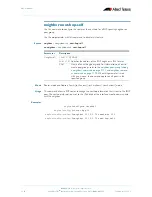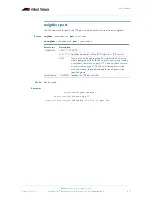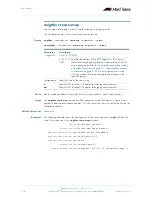
BGP Commands
©2008 Allied Telesis Inc. All rights reserved.
Software Version 5.2.1
AlliedWare Plus
TM
Operating System Software Reference C613-50003-00 REV E
31.79
neighbor route-reflector-client
Use this command to configure the router as a BGP route reflector and configure the specified
neighbor as its client.
Use the
no
parameter with this command to indicate that the neighbor is not a client.
Syntax
neighbor
<
neighborid
>
route-reflector-client
no neighbor
<
neighborid
>
route-reflector-client
Mode
Router mode and Address Family [ipv4 unicast | ipv4 multicast | vpnv4 unicast] mode
Usage
Route reflectors are a solution for the explosion of iBGP peering within an autonomous system.
By route reflection the number of iBGP peers within an AS is reduced. Use the
neighbor
route-reflector-client
command to configure the local router as the route reflector and specify
neighbors as its client.
An AS can have more than one route reflector. One route reflector treats the other route
reflector as another iBGP speaker.
In the following configuration, Router1 is the route reflector for clients 3.3.3.3 and 2.2.2.2; it also
has a non-client peer 6.6.6.6.
Router1#
router bgp 200
neighbor 3.3.3.3 remote-as 200
neighbor 3.3.3.3 route-reflector-client
neighbor 2.2.2.2 remote-as 200
neighbor 2.2.2.2 route-reflector-client
neighbor 6.6.6.6 remote-as 200
Examples
Parameter
Description
<
neighborid
>
{
A.B.C.D
|
TAG
}
A.B.C.D
Specifies the address of the BGP neighbor in IPv4 format.
TAG
Name of an existing peer-group. For information on how to
create peer groups, refer to the
neighbor peer-group (adding
a neighbor) command on page 31.71
,
and
neighbor remote-
as command on page 31.75
. When this parameter is used
with a command, the command applies on all peers in the
specified group.
awplus#
configure terminal
awplus(config)#
router bgp 10
awplus(config-router)#
neighbor 10.10.0.72 route-reflector-
client
















































